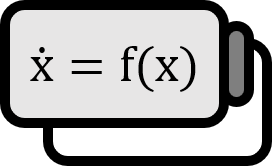Holling type functional response
Overview
When assuming the mass action law applied between predator and prey in models like the ordinary differential equations that model an ecosystem, it is often referred to as functional response. Generally, the number of per consumed by unit predator $x$ is expressed as a function against prey density consumption $f(x)$. One can choose from the following three options, known as Holling’s type functional responses, types 1, 2, and 3.
Explanation

Type 1
Holling’s type 1 functional response is defined as the following linear function. $$ f(x) = a x $$ Here, the parameter $a$ is the discovery rate. The type 1 response is the most basic and widely recognized model seen in the Lotka-Volterra model. $$ \begin{align*} \dot{x} =& rx - axy = rx - f(x)y \\ \dot{y} =& bxy - my \end{align*} $$ At this time, $f(x)$ is derived from the intuitive assumption that predators encounter prey more easily as the number of prey increases, which is directly proportional to the density of the prey.
Type 2
Holling’s type 2 functional response is defined as the following sigmoid function. $$ f(x) = {\frac{ ax }{ 1 + abx }} $$ Here, the parameter $b$ is the handling rate, expressing the reality that, unlike type 1 response where predatory activity can increase indefinitely with prey density, predators need time to kill and digest the prey. Accordingly, from this realistic assumption, the infinite consumption defined in type 1 as $f(x) = ax$ faces a loss of $a b x f(x)$, $$ f(x) = ax - a b x f(x) $$ and it is represented as such. By simplifying this equation for $f(x)$, one obtains the type 2 response function. In contrast, in fraction-form functions, if the handling speed $b$ is extremely fast, the denominator approaches $1$, converging to type 1. In other words, type 2 is a generalization of type 1 in a limiting sense. $$ \lim_{b \to \infty} {\frac{ ax }{ 1 + abx }} = ax $$ A representative example where type 2 response is used is the Kaerik food chain system.
Type 3
Holling’s type 3 functional response is defined by replacing $x$ in the type 2 function with $x^{k}$. $$ f(x) = {\frac{ ax^{k} }{ 1 + abx^{k} }} $$ Here, the parameter $k > 1$ has its motif in the learning of the predator population, indicating that when prey $x$ is sparse, the learning speed is slow and $f(x)$ takes significantly smaller values, yet when prey $x$ is abundant, predatory opportunities increase, and $f(x)$ is relatively larger. Just as type 2 was a generalization of type 1, type 3 is a generalization of type 2 for $k = 1$.
In Dawes’s paper1, the mean field theory approach derives the ordinary differential equations assuming that prey and predators can interact with all nodes on a complete graph. At this point, $k$ is assumed to be a sufficiently large number such that the predator can assess the prey. In other words, a large $k$ implies a considerable experience of prey by the predator, which reflects a more realistic scenario compared to the unrealistic assumption in type 2 response where all predators are instinctively adept at predatory activities, highlighting a need for a learning process in predators.
Dawes, J. H. P., & Souza, M. (2013). A derivation of Holling’s type I, II and III functional responses in predator–prey systems. Journal of theoretical biology, 327, 11-22. https://doi.org/10.1016/j.jtbi.2013.02.017 ↩︎
